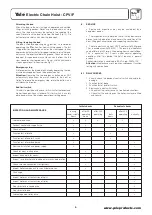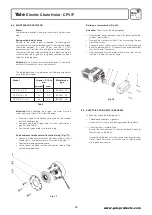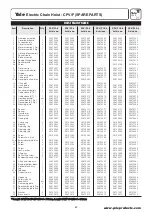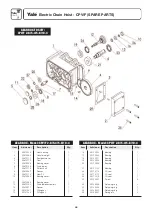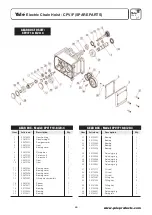
Yale
Electric Chain Hoist - CPV/F
®
4
Temperature range
The units can be operated in ambient temperatures between -10
O
C
and + 40
O
C. Consult Yale in the case of extreme working conditions.
Note:
At ambient temperatures below 0
O
C check the brake is not
frozen.
Theoretical service life
The electric chain hoist is classified to group 1 Am according to FEM
9.511. Basic principles for the calculation of the theoretical remaining
service life are given in BGV D8. When the theoretical remaining
service life has been reached, the electric chain hoist should be
subjected to a general overhaul (also refer to para. 8 maintenance).
Regulations
The Accident Prevention Act and / or Safety Regulations of the
respective country for using manual and electric hoists must be strictly
adhered to.
Maintenance / repair
In order to ensure correct operation, not only the operating
instructions, but also the conditions for inspection and maintenance
must be complied with. If defects are found stop using the hoist /
trolley immediately.
Attention:
Before starting work on electrical components switch OFF
the main current switch and secure it against unintentionally being
switched back on.
3.
INCORRECT OPERATION
• Do not exceed the rated capacity of the hoist / trolley.
• Do not lift or transport tight or jammed loads.
• Excessive inching operation by short and frequent
actuation of the control buttons should be avoided.
• Do not use the hoist / trolley for the transportation of
people (Fig. 3).
• Welding on hook and load chain is strictly forbidden. The
load chain must never be used as a ground connection
during welding (Fig. 4).
• Side pull, i.e. lateral load on either housing or bottom
block (Fig. 5) is not permitted.
Lift only when the load chain forms a straight line between
suspension bracket and hook.
• The load chain must not be used for lashing purposes
(sling chain) (Fig. 6).
Fig. 3
Fig. 4
• Do not knot or shorten the load chain by using bolts,
screws, screwdrivers or other devices (Fig. 7). Do not
repair chains installed in the hoist.
• Do not remove the safety latch from the load hook (Fig. 8).
• Do not use the chain end stop as an operational limit
device (see Fig. 1 - chain end stop).
• Do not throw the hoist or trolley down. Always place it with
care on the ground.
• The unit must not be operated in potentially explosive
atmospheres.
• The longitudinal angle of the runway beam must not
exceed 3%.
• The adjustment of the trolley width must not be extended in
order to e. g. obtain a greater radius curvature.
• Turning of loads under normal operating conditions is not
allowed, as the bottom blocks of the hoists are not
designed for this purpose. If turning of loads is required
as standard, the bottom blocks have to be provided with
swivel hooks supported by axial bearings. In case of
queries, consult the manufacturer.
4.
ASSEMBLY
4.1 INSPECTION BEFORE ASSEMBLY
• Check for transport damage. Check for completeness.
• Check that the capacity indication on hoist and bottom
block match.
4.2 ELECTRIC CHAIN HOIST WITH SUSPENSION BRACKET
(Standard version)
The standard version of the Yale electric chain hoist is provided with
a suspension bracket. The bracket is connected with the housing of
the chain hoist by means of two pins. Make sure that the load hook
– irrespective of the reeving – is always positioned vertically under the
suspension bracket.
Fig. 5
Fig. 6
Fig. 7
Fig. 8
Yale
CPV/F
®









